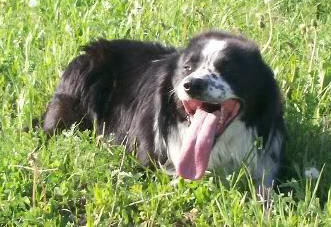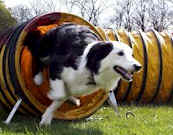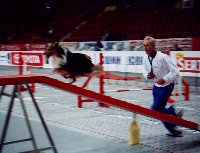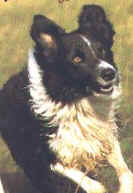Does your high drive dog suffer
from heat intolerance?
 Now
that our weather has turned warmer, have you noticed that your dog overheats rapidly? Does it
put everything into every jump, tunnel, weave poles and after five minutes, it starts panting
dangerously hard. Your dog may suffer from a disorder known as Exercise-induced Hyperthermia (EIH)
or Border Collie Collapse (BCC).
Not much is known about this occurrence except that it is common among highly driven dogs. Mary Whorton thought she had one. When she looked further into this condition, she discovered that
her dog did not, in fact, have EIH. This is what she learned. Now
that our weather has turned warmer, have you noticed that your dog overheats rapidly? Does it
put everything into every jump, tunnel, weave poles and after five minutes, it starts panting
dangerously hard. Your dog may suffer from a disorder known as Exercise-induced Hyperthermia (EIH)
or Border Collie Collapse (BCC).
Not much is known about this occurrence except that it is common among highly driven dogs. Mary Whorton thought she had one. When she looked further into this condition, she discovered that
her dog did not, in fact, have EIH. This is what she learned.
To see them is to believe them. Many heat intolerant dogs
do no more than ten jumps and weave twice before their tongues are hanging out down to their
knees. They are 'driven.' They do not know how to do anything in moderation. You take the lead
off, and they zoom around as fast as they can go. You try to get them to stay and every muscle
is quivering, already using up energy. At the first command they fly at the speed of light.
Sound familiar?
While many dogs get hot when exercising and will pant
profusely and drink lots of water, there is a difference between ordinary overheating and
Exercise-induced Hyperthermia (EIH). The best way to tell if your dog suffers from EIH is by
taking its temperature. The temperature of a dog that is merely 'hot' (i.e. in the first
category) will not usually exceed 103 degrees. If you watch them, they will recover within 15
minutes, provided that they are relatively fit to begin with. The EIH dog may take hours before
it stops panting and its temperature may have reached 105 after only 60 seconds. (If the dog is
out of shape as in overweight and/or flabby, you should not be doing agility in the first
place.)
 What
to look for What
to look for
Though agility dogs are often described as superb athletes at the peak of fitness, EIH
could spell disaster for heat intolerant dogs. This condition occurs more often in male dogs
but has been found in females, too. It is a common occurrence in Border Collies and (in The
States) all three colours of Labradors.
The symptoms consist of:-
- Elevated rectal temp exceeding 105 degrees and staying
above this level for more than 30 minutes. Temperatures have been recorded as high as 109,
perhaps 110.
- Staggering and collapse are not uncommon and can lead
to death.
- Blindness and seizures have been reported during these
episodes.
Dogs who recover after a heat intolerance episode appear
to suffer no ill effects although no one know for certain if long term damage may occur.
 Research Research
Scientists and vets who have been studying this condition are having
a difficult time determining the exact pathology behind the displayed symptoms. Some feel it is
based in a mitochondria defect. They are working on getting grants funded to study further.
The interaction between exercise and the immune system is
an area that has received research interest in several species. Limited data is available on
the interaction of exercise and the immune response in the canine athlete especially during
intense physical stress such as that experienced by sled dogs.
The effect of exercise on the immune response is
variable. It has been reported that intense exercise can be suppressive on the immune response
(Nieman, 1997). Recent research indicates that exhaustive exercise and overtraining in humans
can lead to lower delayed-type hypersensitivity responses (Bruunsgaard et al., 1997), decreased
alveolar Mf microbicidal and anti-viral activity (Davis et al., 1997; Kohut et al., 1998; Wong
et al., 1990), and increased risk for upper respiratory tract infections (Davis et al., 1997;
Wong et al., 1990). Epidemiological and experimental evidence also shows that exercise during
the incubation period of an infection may worsen the prognosis depending on the pathogen (Nieman,
1997).
There may be a genetic predisposition to this condition
but here, once again, no one is completely certain.
 Malignant
Hyperthermia Malignant
Hyperthermia
There is also a condition called Malignant
Hyperthermia which can be present all year round - not just when it is hot. Some feel it may be
connected to the Malignant Hyperthermia in humans. But others do not agree as the human
condition relates to hyperthermia while under anaesthesia which is different from an
exercise-induced condition. MH in humans is autosomal dominant and, thereby, 50% of the
offspring is affected. Nevertheless, it would not hurt to be very careful about anaesthesia if
your dog show symptoms of this disease.
One vet suggested that part of the problem is that a high
drive dog might not breath enough. They may hold their breath instead of breathing when
excited. They don't pant as much as others, and don't appear to relax when the promise of
running or agility is in their head.
Even several hours after the overheating occurred, a vet
can determine whether there are any long-term consequences by doing a blood test. They look for
changes in the blood profile that would indicate liver or kidney damage.
 Working
vs. agility Working
vs. agility
You may wonder why it is that working dogs such as Border Collies can do a
day of sheep herding without over-heating yet boil over when doing five minutes of agility? The
difference may be in the activity. In agility, the dog is going all-out, full speed, non-stop,
and also doing the very strenuous work of lifting his body high off the ground for jumps and
contact obstacles, and vigorously throwing his body side to side going through the weaves. In
agility the dog can be so intent on the course that it hardly seems to remember to breath when
it's running.
In sheep herding, on the other hand, the dog spends a lot
of time in 'stalk' mode, in which it is hardly moving at all, and even when he's doing faster
herding stuff it tends to have an easier canter or trot gait.
If you look at photos of dogs herding, almost without
exception its mouth is open, tongue out, panting. Perhaps it is so intent on what it is doing
in agility that it doesn't pant and that contributes to the overheating? Or maybe the sudden
and strenuous nature of agility (compared to the longer term exertion of herding) doesn't give
the dog's body time to adjust to the changing demands.
 Cool
ideas Cool
ideas
Here are a few things you can do to cool down your dog if it is
really hot.
- Hose down your dog for about 10 minutes to reduce its
temperature. In general there should be no ill effect other than high water intake and
subsequent urinary output over the next several hours!
- Buy a garden sprayer. Spray the under-belly. It works
wonders in cooling down the area.
- Soak an old bath towel in water, wring it out and put
it on the dog, re-wetting when needed.
- Fill a few bottles with water and let your dog lap it
as you pour it into his water bowl.
- Pack a small cooler with crushed ice and give it to
him to eat.
- Keep a kiddie wading pool filled with water so your
dog can dive in it when it gets hot
- Play lots of different kind of games with your dog.
When it is warm, do short burst with lots of energy, then sit down in shade and play
attention and direction games until you both cool off. Then jump up and do some more.
- Invest in a cool mat or a cooler bed that you soak in
cold water. They cool down the dog by evaporation.
- Make some delicious
Pupsicles for your dog.
- Feed your dog only at night, after all work is done.
By the next morning the food will be digested, and it should not matter what was in the diet,
from the perspective of overheating.
- Eliminate grains in your dog's dinner. Change to a
BARF (bones and raw foods) diet.
- If you are training, do short sequences. Then rest and
cool off. Then start again. Remember that training is a lot more intense and stressful both
physically and mentally than simple running.
Feeding
Continued testing at a vet school has discovered
that EIH dogs are often low on taurine, normally thought to be a non-essential amino acid but
apparently important to high drive dogs. There are some who have found a benefit in adding
carnitine, riboflavin, and coenzyme Q10 to the dog's diet. This is currently under study.
There is no consensus as to whether or not adding fat to
the diet will substantially benefit EIH dogs. It might, it might not.
With thanks to the following for their email comments:- Diana
Antlitz, Roger Coor, Helix Fairweather, Ann Gulau, Eileen Madrigale, Pamela Mueller, Joe Sare,
Jennifer Shipley
Feedback
From Dr Janette Mattey BVSc,
BAnSC, CMAVA...
I was reading with interest your article on Exercise Induced Hyperthermia (EIH) in
Border Collies. I noticed you referred to this condition in Labradors. However Labradors -
with almost all cases having been in the USA - suffer from a condition called Exercise Induced
Collapse (EIC).
This difference may seem pedantic, but EIC is due to a
disruption in the transmission of signals to the muscles with rigorous exercise, and is thought
to be related to a mutation of the Dynamin 1 gene. A DNA test is available for this
disease. The nerves that control the muscles do not fire when they are directed to do so, and
this results in collapse, and occasionally death. Dogs are often bright and alert, but may be
confused in severe cases. No seizures are reported with EIC
There are certainly similarities in what you describe and
EIC but, as far as I am aware, a condition of hyperthermia and suspected mitochondrial
dysfunction is not seen in American type Labradors. I would be interested if you have any
updated information on the pathogenesis or genetics of this condition in Border Collies. It
sounds much like Border Collie Collapse, which is thought to be a disease similar to the EIC
seen in Labradors. Research is underway currently to try to identify the genetic mutation and
characterise the disease in Border Collies further at the University of Minnesota, and they are
still taking DNA samples as far as I am aware.
I know the article on your website is a bit out of date
and the information I have provided may already be known to you - but on the off chance you
find this helpful in updating your website I thought I would send it to you just in case! I am
certainly not trying to be at all critical of you site or article. The main thing is to get the
information out there to the dog owners and breeders! (13/02/12)
From Joanne Samuelson
(Perth, Australia)...
I found this article really interesting because for two years
I was told by my vet that they weren't really sure what was wrong with my Australian
Kelpie/Labrador cross but she probably had some form of epilepsy because of the seizures.
Karla had all the symptoms that this articles talks
about. Anyway, 'probably' didn't satisfy me, and I know that it wasn't epilepsy because as a
child I had known a few humans with this disease and quivering seizure like symptoms were not
the same as an epileptic fit.
Karla was fully conscious, panting so fast that she
couldn't get air into the blood stream which was evident by the blueness of the tongue and
gums, and it always began with lose of balance. It reminded me of athletes when they hit 'the
wall' as they say and loose muscle control.
Anyway, I started looking into things myself and came
across a lady who raced greyhounds and she told me about a condition in racing dogs that they
called 'tie out' syndrome. It effected dogs that got extremely excited at race meetings and
would collapse after the race was run. All the symptoms sounded just like Karla.
I now use a re-hydration supplement on Karla's dinner
every night and add re-hydration fluid to her water when training and for over 12 months we
have not had one seizure. I can work her for much longer periods of time, more often than
before and no matter the whether, though I don't work any of my dogs in hot weather anyway.
Everything that Karla does is at full speed; there are no halves with her especially with
agility.
While I have complete trust in my vet and they serve me
well, sometimes you have to not except the answer you get and do your own looking. For anyone
out there that has a dog that is full on and loves to run, jump and play but has this problem,
I can say that re-hydration supplements have worked for me. (29/12/02)
From Dee
Quaschnik...
It's interesting to come across this article. We've recently gotten our
JRTs into chasing the beach-type ball around the back yard, pushing and biting at it at full
speed, working together to get the momentum. I worry about them overheating and so I watch for
them to start slowing down and put it up. It only takes about 5-10 minutes and they've been
exhausted. The eight year old female is the most worrisome because she lies down and pants her
little heart out. I've taken to encouraging the drinking water and following suit of the three
month old baby that stands IN the water pan while drinking if she is hot. I think they
understand it helps to cool them off a bit.
I appreciate the issue being addressed and options
of things to do. Thank you so much! (31/08/01)
From
Jackie Bromwich...
Interesting article - I have a border collie who is
very typical of this - she gives 110% in everything, but if I am not very careful she overdoes
it and becomes overheated. She staggers, pants deeply, her legs are stiff and uncoordinated as
though she has had a general aesthetic, her eyes glaze and she has, on occasion, appeared to be
about to fit. It takes her roughly 30 minutes or so to recover.
My sister also has a sheepdog who gets in the same state
if he has a hard trial on a warm day, or in general work on the farm - so it is not only
agility dogs. Talking to trials people, there are actually quite a few dogs that get overheated
like this when they are working sheep, and I have also heard of it in lurchers after a long and
arduous course. (Chasing type of course, not agility type of course!).
(04/08/01)
From Jane Tatam...
I read your article with interest.
I don't know if any of the following is any use. I have
two Papillons, one ultra large, one ultra small. The moment we have a hot day neither want to
run fast in the ring, and will put something like 16-18 seconds (!) on their average time,
running them is rather like trying to push a rock up a hill. So I'm not just talking about a
slight slowing down.
We live right by the sea so neither live in a hot
environment and they don't moult. They don't show any signs of overheating (as your article
describes) but act as though they intend to avoid the problem! Both become listless and normal
stimuli like balls and food cease to work. It seems to me that they find the waiting as
exhausting as the running, despite creating decent shade for them! Queues at events will work
as a total turn-off.
I have tried putting rock sulphur in their drinking water
and also give them the homeopathic remedy, sulphur (one a day normally during hot weather,
three a day at shows). I have been thinning out their very thick coats.
At shows I have also tried adding a product called Hot
Dog to their drinking water (http://www.companionschoice.com/heat.htm). Trouble is they then
won't touch the water so I have to give tidbits in the water for them to fish out. Reducing
food to less meals seems not to have a beneficial effect, so I give a high carbohydrate lunch
snack (a charcoal flavoured Bonio) when I know they won't have to run for a while.
In addition, I thoroughly wet their ears as well as
wetting underbellies and using towels. It's sort of working in that I might get one decent run,
one half-decent run, but definitely not three!
Going for a walk does not produce the same problems
despite quite violent play so I'm not entirely sure what is going on. Sometimes I suspect that
heat simply induces listlessness which is worsened by the high degree of non-relaxed
non-activity at shows. But that doesn't quite square with your sheep dog analogy.
At times like this I really wish I could have a chat with
both my dogs just to discover what is really going on. I do hope others will respond to your
article to throw more light on the problem, as I really feel I'm toying with something I don't
fully understand.
Collie weaving photo by Tien Trans. Fly owned by Daisy Peel.
|